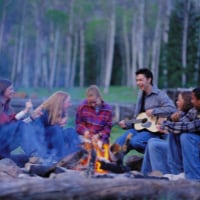Prevent Burns this Summer
By: Andrea Wetherill, MSN, RN, Trauma Program Manager, Fisher-Titus and MetroHealth Trauma Partnership
May is nationally recognized as trauma awareness month. In recognition of injury prevention, below, you will find some fire safety tips to prevent injuries while enjoying summertime. Now is the perfect time to brush up on safety tips, check your first aid supplies, and make sure you know when to seek medical attention for an injury. 
Campfire and Fire Pit Safety
As the weather improves, it’s likely that many of us will be enjoying time roasting marshmallows and sitting around a fire. However, it’s important to remember that even in a controlled setting such as when utilizing a fire pit, fire is still dangerous, especially with young children. Before you get started this summer, keep these campfire and fire pit safety tips in mind:
- Do not leave children unattended around the fire
- Avoid usage of accelerants
- Do not allow children to run around the fire
- Do not allow children to be barefoot around the fire
- Do not leave a lit fire unattended
- Follow local city ordinances for recreational fires
- Drink responsibly
- Have a working fire extinguisher ready to properly extinguish fire
- Teach children that embers are hot and remain hot for prolonged periods of time
When to seek medical attention
Even when taking precautions accidents can happen, and you may end up with a burn. Here are some tips for knowing when a burn requires medical attention:
- Large burns with blistering or sloughing of skin
- Circumferential burns (burns that affect the entire circumference of a digit or extremity)
- Trouble breathing post exposure to smoke
- Uncontrollable pain
Burn care supplies to have available at home
When you head to the store to buy your cookout food, also make sure you are stocked up on these items that are important to have on hand in case of a burn:
- Dry, sterile dressings
- Antibiotic or burn cream (only use if you are not seeking immediate medical attention).
Tips for caring for a burn at home
If you suffer from a burn and decide not to seek emergency medical attention, we recommend these tips:
- Apply a dry sterile dressing immediately to any thermal burn. This decreases air exposure which allows for better pain control and limits chance of infection.
- If not seeking immediate medical attention, lightly cleanse the burn with soap and water, you may then apply antibiotic or burn cream. (Only a thin layer of application to the burn is necessary).
- At minimum, our service recommends outpatient follow up with your primary care provider or a burn clinic for large burns, burns containing blisters, burns with signs and symptoms of infection, including colored and/or foul-smelling drainage, and uncontrolled pain.
- Do not saturate thermal burns in water or utilize cool rags/dressings. (This advice strictly applies to thermal burns NOT chemical burns, as care of chemical burns is not discussed within this article).
